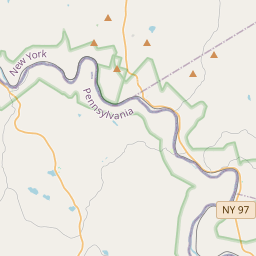Long Eddy Hotel
Historical marker location:
7 Depot Street, Long Eddy, New York
( Marker is on Depot Street south of New York State Route 97, on the left when traveling south.)







© OpenStreetMap contributors
Loading...
Searching for other points of interest within 3 miles of this location.The Woodstock Music Festival, which is considered a seminal moment in American cultural history, did not actually take place in the town of Woodstock, New York. The festival was held on a dairy farm in nearby Bethel, New York, about 60 miles south of Woodstock.
About Sullivan County
Sullivan County Timeline
Sullivan County, located in the southern part of New York State, has a rich and diverse history that spans over several centuries. The region was originally inhabited by various Native American tribes, such as the Lenape people, who relied on the land's resources for their sustenance and way of life.
European settlement in Sullivan County began in the early 18th century, with the arrival of Dutch and English settlers. The area quickly became known for its fertile land and natural resources, attracting more settlers seeking opportunities for farming, lumbering, and trading. The county's development accelerated with the construction of the Delaware and Hudson Canal in the mid-19th century, which connected the region to New York City and facilitated the transport of goods.
Sullivan County experienced significant growth and prosperity during the late 19th and early 20th centuries, particularly with the rise of tourism. The region's picturesque landscapes, including the Catskill Mountains and the many lakes and rivers, attracted city-dwellers who sought refuge from urban life. The county became a popular vacation destination, known for its grand resorts, guesthouses, and outdoor activities such as fishing, hunting, and hiking.
In the mid-20th century, Sullivan County gained national recognition as the epicenter of the Borscht Belt, a popular vacation spot for Jewish families from the 1920s to the 1970s. Numerous resorts and entertainment venues flourished, hosting renowned comedians, musicians, and performers. However, the decline of the Borscht Belt began in the 1960s, as changing vacation preferences and economic factors led to the closure of many resorts.
Today, Sullivan County continues to embrace its natural beauty, promoting outdoor recreation and attracting visitors with its state parks, scenic trails, and opportunities for boating, camping, and skiing. The county also remains a popular destination for artists, musicians, and writers seeking inspiration from its serene landscapes. Through its history, Sullivan County has evolved from a Native American territory to a thriving agricultural and tourism hub, leaving a lasting legacy as a place where nature, culture, and relaxation converge.
European settlement in Sullivan County began in the early 18th century, with the arrival of Dutch and English settlers. The area quickly became known for its fertile land and natural resources, attracting more settlers seeking opportunities for farming, lumbering, and trading. The county's development accelerated with the construction of the Delaware and Hudson Canal in the mid-19th century, which connected the region to New York City and facilitated the transport of goods.
Sullivan County experienced significant growth and prosperity during the late 19th and early 20th centuries, particularly with the rise of tourism. The region's picturesque landscapes, including the Catskill Mountains and the many lakes and rivers, attracted city-dwellers who sought refuge from urban life. The county became a popular vacation destination, known for its grand resorts, guesthouses, and outdoor activities such as fishing, hunting, and hiking.
In the mid-20th century, Sullivan County gained national recognition as the epicenter of the Borscht Belt, a popular vacation spot for Jewish families from the 1920s to the 1970s. Numerous resorts and entertainment venues flourished, hosting renowned comedians, musicians, and performers. However, the decline of the Borscht Belt began in the 1960s, as changing vacation preferences and economic factors led to the closure of many resorts.
Today, Sullivan County continues to embrace its natural beauty, promoting outdoor recreation and attracting visitors with its state parks, scenic trails, and opportunities for boating, camping, and skiing. The county also remains a popular destination for artists, musicians, and writers seeking inspiration from its serene landscapes. Through its history, Sullivan County has evolved from a Native American territory to a thriving agricultural and tourism hub, leaving a lasting legacy as a place where nature, culture, and relaxation converge.
Sullivan County Timeline
This timeline provides a concise overview of the key events in the history of Sullivan County, New York.
- 1703- Sullivan County was originally part of Ulster County, NY.
- 1809- Sullivan County was formed and named after General John Sullivan, a Revolutionary War hero.
- 1800s- The area was primarily agricultural, with farming and logging as major industries.
- 1848- The Erie Railroad reached Sullivan County, spurring economic growth and tourism.
- 1881- The Monticello and Port Jervis Railroad opened, further improving transportation in the county.
- 1900s- The tourism industry boomed, with the county becoming a popular destination for city dwellers seeking fresh air and outdoor activities.
- 1960s-70s- The construction of the Monticello Raceway and the opening of several large resorts brought more tourism and jobs to the area.
- 1997- The county faced economic decline as resorts closed, leading to a focus on revitalization and diversifying the local economy.
- Present- Sullivan County remains a popular destination for outdoor enthusiasts, with a growing arts and culture scene.